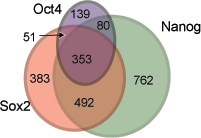 |
|
Core Transcriptional Regulatory Circuitry in Human Embryonic Stem Cells
Acknowledgements References |
We next identified protein-coding and miRNA genes targeted by the stem cell regulators Sox2 and Nanog using location analysis. Sox2 and Nanog were found associated with 1271 (7%) and 1687 (9%), respectively, of the promoter regions for known protein-coding genes in human ES cells (Supplemental Data Table S2 - S4). It was immediately evident that many of the target genes were shared by Oct4, Sox2, and Nanog (Figure 2A). Examples of protein-coding genes that are co-occupied by the three regulators are shown in Figure 2B (Supplemental Data Table S5). Control experiments showed that the set of promoters bound by the cell cycle transcription factor E2F4 in these human ES cells did not overlap substantially with those bound by the three stem cell regulators (Supplemental Data Table S2 and S6). We found that Oct4, Sox2 and Nanog together occupy at least 353 genes in human ES cells. Previous studies have shown that Sox2 and Oct4 can interact cooperatively to synergistically activate transcription of target genes in murine ES cells and that this activity is dependent upon the juxtaposition of Oct4 and Sox2 binding sites (Ambrosetti et al., 1997; Remenyi et al., 2004). Our results revealed that approximately half of the genes occupied by Oct4 were also bound by Sox2 in human ES cells (Figure 2A; Supplemental Data Table S2). It was surprising, however, to find that >90% of promoter regions bound by both Oct4 and Sox2 were also occupied by Nanog. Furthermore, Oct4, Sox2, and Nanog binding sites occured in close proximity at nearly all of the genes that they co-occupied (Figure 2C). These data suggest that Oct4, Sox2 and Nanog function together to regulate a significant proportion of their target genes in human ES cells. A class of small non-coding RNAs known as microRNAs (miRNA) play vital roles in gene regulation and recent studies indicate that more than a third of mammalian protein-coding genes are conserved miRNA targets (Bartel, 2004; Lewis et al., 2005). ES cells lacking the machinery that processes miRNA transcripts are unable to differentiate (Kanellopoulou et al., 2005). Moreover, recent evidence indicates that microRNAs play an important role in organismal development through regulation of gene expression (Pasquinelli et al., 2005). Oct4, Sox2, and Nanog were found associated with 14 miRNA genes and co-occupied the promoters of at least two miRNA genes, mir-137 and mir-301 (Table 1). Our results suggest that miRNA genes which have been implicated in developmental processes are likely regulated by Oct4, Sox2 and Nanog in human ES cells and are important components of the transcriptional regulatory circuitry in these cells. 
miRNA Loci Near Oct4, Sox2 and Nanog Bound Regions (Table 1) Known Genes bound by Oct4, Sox2, Nanog, and E2F4 in ES cells (Table S2) Promoter Regions bound by Sox2 in ES cells (Table S3) Promoter Regions bound by Nanog in ES cells (Table S4) Genes Co-Occupied By Oct4, Sox2 and Nanog in ES cells (Table S5) Regions of the Genome Bound By E2F4 in ES cells (Table S6) |
| YOUNG
LAB
Whitehead Institute 9 Cambridge Center Cambridge, MA 02142 [T] 617.258.5218 [F] 617.258.0376 CONTACT US |